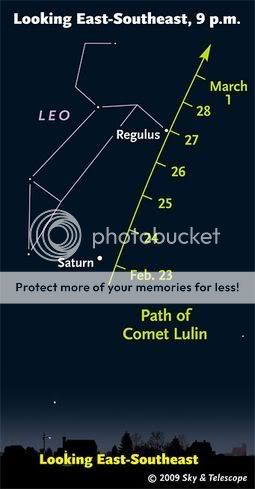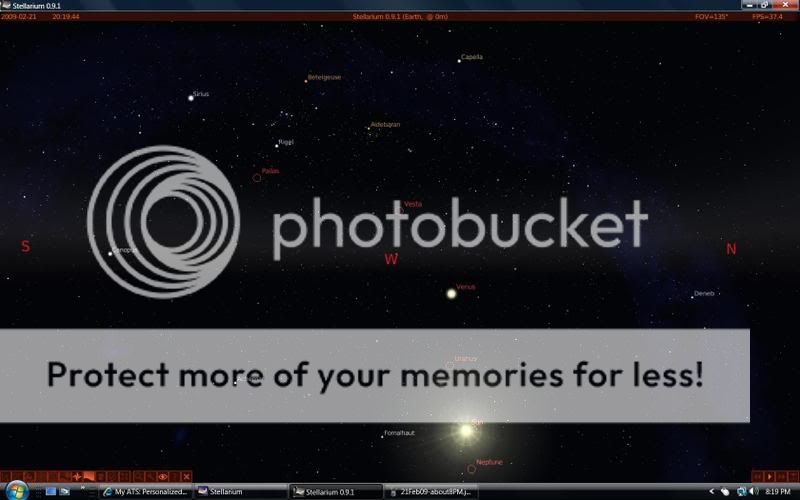It looks like you're using an Ad Blocker.
Please white-list or disable AboveTopSecret.com in your ad-blocking tool.
Thank you.
Some features of ATS will be disabled while you continue to use an ad-blocker.
share:
I created a planisphere of the night in question using google sky and a helpful planisphere tool online. Only when I displayed a planisphere from
Arizona on the night in question, Venus is below the Western Horizon..
This image might be hard to see. The W on the green line represents the Western Horizon on Saturday Night from this location. I circled the planet Venus twice with red circles to show that it is indeed below the horizon..

So I did some checking..
What I found about Comet Lulin (as some think this was)
www.skyandtelescope.com...
To put this in perspective... from
en.wikipedia.org...
This link shows the apparent magnitudes of common astronomical objects. As this shows, a magnitude 5.6 comet probably wouldn't have even been visible (if so.. barely visible to the naked eye.. Completely invisible to any unaided video camera).
Comet Lulin is actually in the East/Southeast as this so aptly illustrates:
From.. www.skyandtelescope.com...

And here is what Lulin looked like on the night in question as the tail starts to become larger. Though this photo is probably taken with a telescope using a CCD camera which would have made the comet look much brighter than it actually is in the night sky. Most astronomy photos you see are taken using this method although it is actually a little more complicated.. The overall method involves a CCD camera with a computer chip that is basically a light sensor that takes digital photos of what the telescope sees..

Not quite what this object looked like although it is similar. The area of the sky is completely opposite where the bright object in the video sits in the sky. If this camera was even looking at the area of the comet it wouldn't have even been able to see it due to it's apparent magnitude of 5.6 .. This object in the video is extremely bright.. probably in the range of Venus or brighter (Venus usually has a minimum magnitude of -3.7 to put this in perspective. The sun has a magnitude of about -26.73).. This object in the video was extremely bright, probably at least a -4 and probably higher than that still.
This is interesting when you consider nothing was there in the night sky that should have been that bright.. Venus was below the horizon too. And no other planets with that kind of brightness/magntiude were anywhere near the Western sky on that night.
In fact, there weren't any planets in the Wesern sky at all from what I can tell. The only "bright" object in the Western sky on that night was a star called "Sirius" in the constellation Canis Majoris which sits just to the left of Orion in the night sky. Basically.. Draw a line with orions belt to the left and it will point you to this star. It is the brightest star in the northern hemisphere that is actually a star and not a planet. It is relatively bright.. But, IMO, still nowhere near the brightness of the object in the video.
-ChriS
[edit on 24-2-2009 by BlasteR]
This image might be hard to see. The W on the green line represents the Western Horizon on Saturday Night from this location. I circled the planet Venus twice with red circles to show that it is indeed below the horizon..

So I did some checking..
What I found about Comet Lulin (as some think this was)
www.skyandtelescope.com...
Comet Lulin this week is at its brightest and closest to Earth — right when the sky is conveniently moonless. Use binoculars or a telescope to look for it once it's well up in late evening. The comet is glowing at about magnitude 5.6 as it moves rapidly westward across Virgo.
To put this in perspective... from
en.wikipedia.org...
This link shows the apparent magnitudes of common astronomical objects. As this shows, a magnitude 5.6 comet probably wouldn't have even been visible (if so.. barely visible to the naked eye.. Completely invisible to any unaided video camera).
3 Faintest stars visible in an urban neighborhood with naked eye
4.6 Maximum brightness of Ganymede
5.5 Maximum brightness of Uranus
6.5 Faintest stars observable with naked eye under perfect conditions
Text
Comet Lulin is actually in the East/Southeast as this so aptly illustrates:
From.. www.skyandtelescope.com...

And here is what Lulin looked like on the night in question as the tail starts to become larger. Though this photo is probably taken with a telescope using a CCD camera which would have made the comet look much brighter than it actually is in the night sky. Most astronomy photos you see are taken using this method although it is actually a little more complicated.. The overall method involves a CCD camera with a computer chip that is basically a light sensor that takes digital photos of what the telescope sees..

Not quite what this object looked like although it is similar. The area of the sky is completely opposite where the bright object in the video sits in the sky. If this camera was even looking at the area of the comet it wouldn't have even been able to see it due to it's apparent magnitude of 5.6 .. This object in the video is extremely bright.. probably in the range of Venus or brighter (Venus usually has a minimum magnitude of -3.7 to put this in perspective. The sun has a magnitude of about -26.73).. This object in the video was extremely bright, probably at least a -4 and probably higher than that still.
This is interesting when you consider nothing was there in the night sky that should have been that bright.. Venus was below the horizon too. And no other planets with that kind of brightness/magntiude were anywhere near the Western sky on that night.
In fact, there weren't any planets in the Wesern sky at all from what I can tell. The only "bright" object in the Western sky on that night was a star called "Sirius" in the constellation Canis Majoris which sits just to the left of Orion in the night sky. Basically.. Draw a line with orions belt to the left and it will point you to this star. It is the brightest star in the northern hemisphere that is actually a star and not a planet. It is relatively bright.. But, IMO, still nowhere near the brightness of the object in the video.
-ChriS
[edit on 24-2-2009 by BlasteR]
I downloaded a freeware astronomy program and set the sky to the same night and around 8 o'clock. I wanted to do this just to check that Venus was
indeed below the horizon at that time. It turns out that it was.
This is what I saw.. No Venus in the sky.. No planet even in this entire part of the Western night sky. This first photo shows the night sky as it would look surrounded by ocean just to give an accurate representation of objects above and below the horizon. No venus in sight.

This second photo shows the same thing only without the ocean landscape. You can see venus in this image behind where the horizon would be.. proving that it was not visible that night in Arizona. You can also see the sun in this screenshot

-ChriS
It was below the Western Horizon before it even got dark out. So it seems that it couldn't have been Venus.
[edit on 24-2-2009 by BlasteR]
This is what I saw.. No Venus in the sky.. No planet even in this entire part of the Western night sky. This first photo shows the night sky as it would look surrounded by ocean just to give an accurate representation of objects above and below the horizon. No venus in sight.

This second photo shows the same thing only without the ocean landscape. You can see venus in this image behind where the horizon would be.. proving that it was not visible that night in Arizona. You can also see the sun in this screenshot

-ChriS
It was below the Western Horizon before it even got dark out. So it seems that it couldn't have been Venus.
[edit on 24-2-2009 by BlasteR]
reply to post by BlasteR
great researching! I was trying to find out anything new on this article, I am not finding any updates, I expected to find out it was Lulin passing by, but as of right now there is no other word on this particular sighting.
great researching! I was trying to find out anything new on this article, I am not finding any updates, I expected to find out it was Lulin passing by, but as of right now there is no other word on this particular sighting.
new topics
-
A Warning to America: 25 Ways the US is Being Destroyed
New World Order: 1 hours ago -
President BIDEN's FBI Raided Donald Trump's Florida Home for OBAMA-NORTH KOREA Documents.
Political Conspiracies: 7 hours ago -
Maestro Benedetto
Literature: 8 hours ago -
Is AI Better Than the Hollywood Elite?
Movies: 9 hours ago
